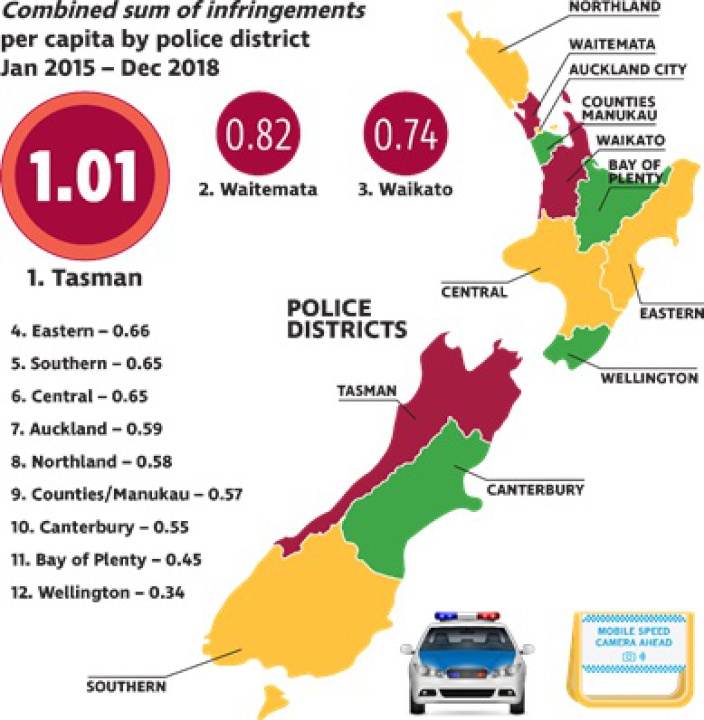Heat map reveals New Zealand’s worst speed offenders
Heat map reveals New Zealand’s worst speed offenders by district

Auckland, 24 June
2019 – Residents of the Nelson Bays, the West
Coast and Marlborough need to hit the brakes, according to
New Zealand Police data analysed by Teletrac Navman, specialists in
GPS-based fleet management technology.
Teletrac Navman’s analysis of speeding tickets in the Tasman Police District (issued via mobile speed camera and road-side enforcement) found a speeding infringement level of 1.01 per capita over four years. The district includes the Nelson Bays, the West Coast and Marlborough. The second highest speed infringements per capita was Waitemata (which includes some of the country’s largest motorways) at a rate of 0.82, followed by Waikato at 0.74 per capita.
Wellington (including Hutt Valley, Kapiti-Mana and the Wairarapa) had the lowest number of combined speeding infringements per capita at 0.34.
“When I was a police officer, it was my job to knock on people’s door and tell them that the person they loved had died in a road collision. It’s not a part of the job that any officer enjoys,” says Chris L’Ecluse, former Western Australian Police Officer and Solutions Specialist at Teletrac Navman. “We analysed the data and developed this infographic to highlight the issue of speeding. New Zealanders all over the country need to slow down on the roads – perhaps a little regional comparison will help get that message across.”
“What’s particularly alarming is that the Tasman Police District has plenty of open road, meaning that people breaking the speed limit will very often be going well over 100km per hour. Speed is a key component to stopping distances, travelling at 100km per hour gives a stopping distance of approximately 50m. Brake Charity estimated that for every 2km reduced in speed, a collision is 5 per cent less likely to happen.”
Ministry of Transport data shows that speed (defined as driving too fast for the conditions) is a contributing factor in around one third of all fatal crashes. Average deaths per day over last 10 years has reached around 0.9, or about one person per day. Therefore, approximately one person loses their life on New Zealand roads every three days due to driver speed.
“Everyone has a part to play, including businesses that have fleet vehicles,” says L’Ecluse. “If loss of life is not incentive enough, do it for your wallet. GPS and location enabled services that telematics data provides can verify that slowing down reduces fuel consumption, reduces vehicle wear and tear, and reduces fines.”
The infographic is based on New Zealand Police’s road policing data from January 2015 – December 2018. The totals of Officer Issued Speed Infringements and Mobile Speed Camera Infringements were added together and weighted against the police district’s population. Static Camera-issued speed offences were not included in the data as it is more likely drivers would know the location of these cameras and slow down accordingly.
The infographic can be accessed on Teletrac Navman’s website.
References
New Zealand Police (2019) Road policing offences data January 2009 – March 2019. https://www.police.govt.nz/about-us/publication/road-policing-driver-offence-data-january-2009-march-2019
Ministry of Transport (2017) Speed Fact Sheet. https://www.transport.govt.nz/assets/Uploads/Research/Documents/262ce6671f/Speed-2017.pdf
Brake Charity (2018) More 30km/h speed limits needed says road safety charity
Driving Tests (n.d)
https://www.drivingtests.co.nz/resources/how-to-calculate-braking-distances/
###
About Teletrac Navman
Teletrac Navman is a leading software-as-a-service (SaaS) provider leveraging location-based technology and services for managing mobile assets. With specialised solutions that deliver greater visibility into real-time insights and analytics, Teletrac Navman helps companies make better business decisions that enhance productivity and profitability. Its fleet and asset management technology uncovers information that would otherwise go unseen, helping customers reduce risk and confidently move their business forward with certainty. It tracks and manages more than 550,000 vehicles and assets for more than 40,000 companies around the world. The company is headquartered in Glenview, IL, with additional offices in the United States, United Kingdom, Australia, New Zealand and Mexico. For more information visit teletracnavman.com.
ends


 Office of the Privacy Commissioner: New Research Shows Business Leaders Fear Being On The Hook For Others’ Privacy Breaches
Office of the Privacy Commissioner: New Research Shows Business Leaders Fear Being On The Hook For Others’ Privacy Breaches E Tū: E Tū Members Send Open Letter To James Grenon And NZME Board
E Tū: E Tū Members Send Open Letter To James Grenon And NZME Board Commerce Commission: Commission Calls For Comments On Copper Access Deregulation
Commerce Commission: Commission Calls For Comments On Copper Access Deregulation New Zealand Association of Scientists: NZAS Supports Saving Biotechnology Capacity In Callaghan; Asks What Now For Applied Technology Group
New Zealand Association of Scientists: NZAS Supports Saving Biotechnology Capacity In Callaghan; Asks What Now For Applied Technology Group Stats NZ: Business Employment Data - December 2024 Quarter
Stats NZ: Business Employment Data - December 2024 Quarter Transpower: System Operator Launches Review Of Electricity Risk Forecasting Framework
Transpower: System Operator Launches Review Of Electricity Risk Forecasting Framework 



